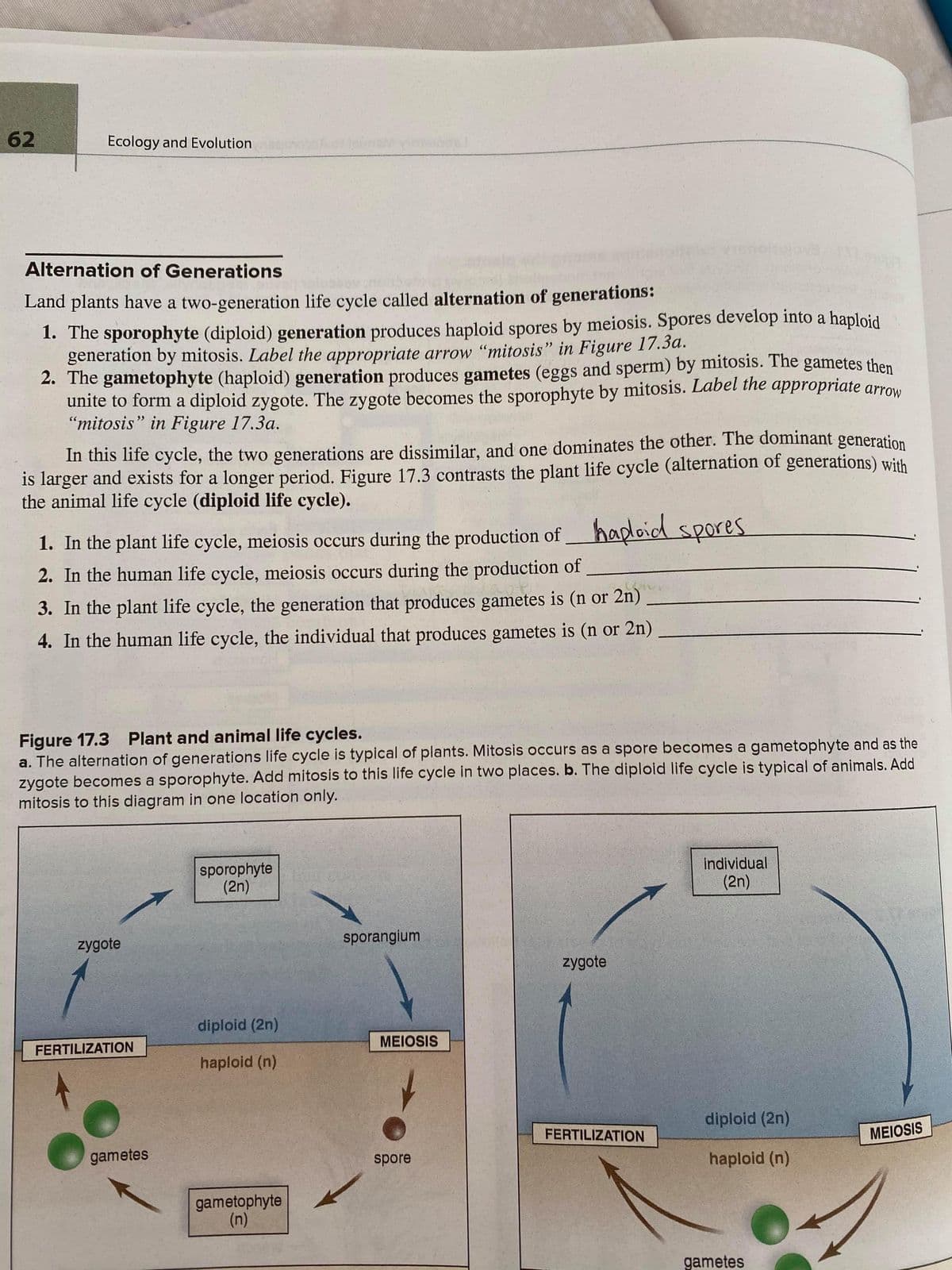2. In the human life cycle, meiosis occurs during the production of 3. In the plant life cycle, the generation that produces gametes is (n or 2n) 4. In the human life cycle, the individual that produces gametes is (n or 2n)
2. In the human life cycle, meiosis occurs during the production of 3. In the plant life cycle, the generation that produces gametes is (n or 2n) 4. In the human life cycle, the individual that produces gametes is (n or 2n)
Biology 2e
2nd Edition
ISBN:9781947172517
Author:Matthew Douglas, Jung Choi, Mary Ann Clark
Publisher:Matthew Douglas, Jung Choi, Mary Ann Clark
Chapter25: Seedless Plants
Section: Chapter Questions
Problem 7RQ: How does a haplontic plant population maintain genetic diversity? Zygotes are produced by random...
Related questions
Question
100%

Transcribed Image Text:62
Ecology and Evolution
Alternation of Generations
Land plants have a two-generation life cycle called alternation of generations:
1. The sporophyte (diploid) generation produces haploid spores by meiosis. Spores develop into a haploid
generation by mitosis. Label the appropriate arrow "mitosis" in Figure 17.3a.
2. The gametophyte (haploid) generation produces gametes (eggs and sperm) by mitosis. The gametes then
unite to form a diploid zygote. The zygote becomes the sporophyte by mitosis. Label the appropriate arrow
"mitosis" in Figure 17.3a.
In this life cycle, the two generations are dissimilar, and one dominates the other. The dominant generation
is larger and exists for a longer period. Figure 17.3 contrasts the plant life cycle (alternation of generations) with
the animal life cycle (diploid life cycle).
1. In the plant life cycle, meiosis occurs during the production ofhaploid spores
2. In the human life cycle, meiosis occurs during the production of
3. In the plant life cycle, the generation that produces gametes is (n or 2n)
4. In the human life cycle, the individual that produces gametes is (n or 2n)
Figure 17.3 Plant and animal life cycles.
a. The alternation of generations life cycle is typical of plants. Mitosis occurs as a spore becomes a gametophyte and as the
zygote becomes a sporophyte. Add mitosis to this life cycle in two places. b. The diploid life cycle is typical of animals. Add
mitosis to this diagram in one location only.
sporophyte
(2n)
individual
(2n)
zygote
sporangium
zygote
diploid (2n)
FERTILIZATION
MEIOSIS
haploid (n)
diploid (2n)
FERTILIZATION
MEIOSIS
gametes
spore
haploid (n)
gametophyte
(n)
gametes
Expert Solution
This question has been solved!
Explore an expertly crafted, step-by-step solution for a thorough understanding of key concepts.
This is a popular solution!
Trending now
This is a popular solution!
Step by step
Solved in 2 steps

Knowledge Booster
Learn more about
Need a deep-dive on the concept behind this application? Look no further. Learn more about this topic, biology and related others by exploring similar questions and additional content below.Recommended textbooks for you

Biology 2e
Biology
ISBN:
9781947172517
Author:
Matthew Douglas, Jung Choi, Mary Ann Clark
Publisher:
OpenStax

Biology: The Dynamic Science (MindTap Course List)
Biology
ISBN:
9781305389892
Author:
Peter J. Russell, Paul E. Hertz, Beverly McMillan
Publisher:
Cengage Learning

Biology: The Unity and Diversity of Life (MindTap…
Biology
ISBN:
9781337408332
Author:
Cecie Starr, Ralph Taggart, Christine Evers, Lisa Starr
Publisher:
Cengage Learning

Biology 2e
Biology
ISBN:
9781947172517
Author:
Matthew Douglas, Jung Choi, Mary Ann Clark
Publisher:
OpenStax

Biology: The Dynamic Science (MindTap Course List)
Biology
ISBN:
9781305389892
Author:
Peter J. Russell, Paul E. Hertz, Beverly McMillan
Publisher:
Cengage Learning

Biology: The Unity and Diversity of Life (MindTap…
Biology
ISBN:
9781337408332
Author:
Cecie Starr, Ralph Taggart, Christine Evers, Lisa Starr
Publisher:
Cengage Learning

Biology: The Unity and Diversity of Life (MindTap…
Biology
ISBN:
9781305073951
Author:
Cecie Starr, Ralph Taggart, Christine Evers, Lisa Starr
Publisher:
Cengage Learning